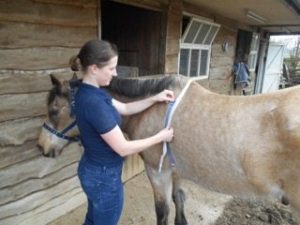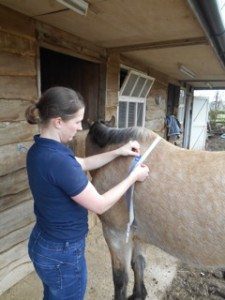
Worming your horse
Spring is here and it’s a good time to think about your horses worming plan. All you need to get started is to collect a small amount of fresh dung for each horse and its field companions and have a simple worm egg count test performed.
We only need 3 grams of dung, about the size of a small date. This is mixed into a solution which suspends the eggs so that they can be seen under the microscope and counted. The result shows how many active, adult, egg laying parasites there are inside the horses gut at that time. This is known as a targeted approach that helps to identify those horses with high worm burdens of more than 200 eggs per gram of dung. This then enables those horses to be treated with the appropriate wormer.
Worm egg counts prevent the un-necessary and ineffective use of wormers, save money for those horses not needing treatment and minimises the problem of resistance. Resistance to a wormer is where the product used becomes ineffective at killing the intended parasite.
The most common parasites seen in the adult horse and that we routinely treat for are large strongyles (redworm), small strongyles (cyathostomes), roundworms, tapeworms, pinworms and bots.
Those horses with high counts will then need to have their bodyweight taken so they can receive the correct amount of product for treatment. A weigh bridge provides the most accurate method but body weight can also be estimated by the use of a weigh tape and by the use of measurements and calculations.
Then we need to administer the recommended treatment product correctly.
Wormers come in many formulations from oral pastes, liquids, chewable tablets and powders. If using powders or liquids I would recommend mixing them with part of the feed ration and include succulents or flavours to tempt them to eat it first, then once eaten the remaining ration can be fed.
When using oral pastes the dial needs to be turned along to the correct amount for the horse’s body weight. Don’t give any feed prior to the treatment as the food present in the mouth will potentially be spat out along with the wormer.
Ensure you have suitable restraint of your horse and in a relatively confined area of the yard or stable. Stand to the side of your horse, in front of their shoulder and guide the syringe into the corner of their mouth. Aim for the back of the tongue and dispense the wormer. Then raise the head for a few minutes to ensure it is swallowed.
Other things you can be doing to keep the pasture parasite burden down include;
- Regular dung collection, at least 2-3 times a week
- Avoid overstocking and over grazing, 1.5 acre (0.4 hectares) per horse ideally
- Rotate paddocks with alternating periods of rest and cross grazing cattle and or sheep toclean up the deposited eggs and larvae
- Test all new horses upon arrival
-
Test and treat all in the herd at the same time.





Recent Comments